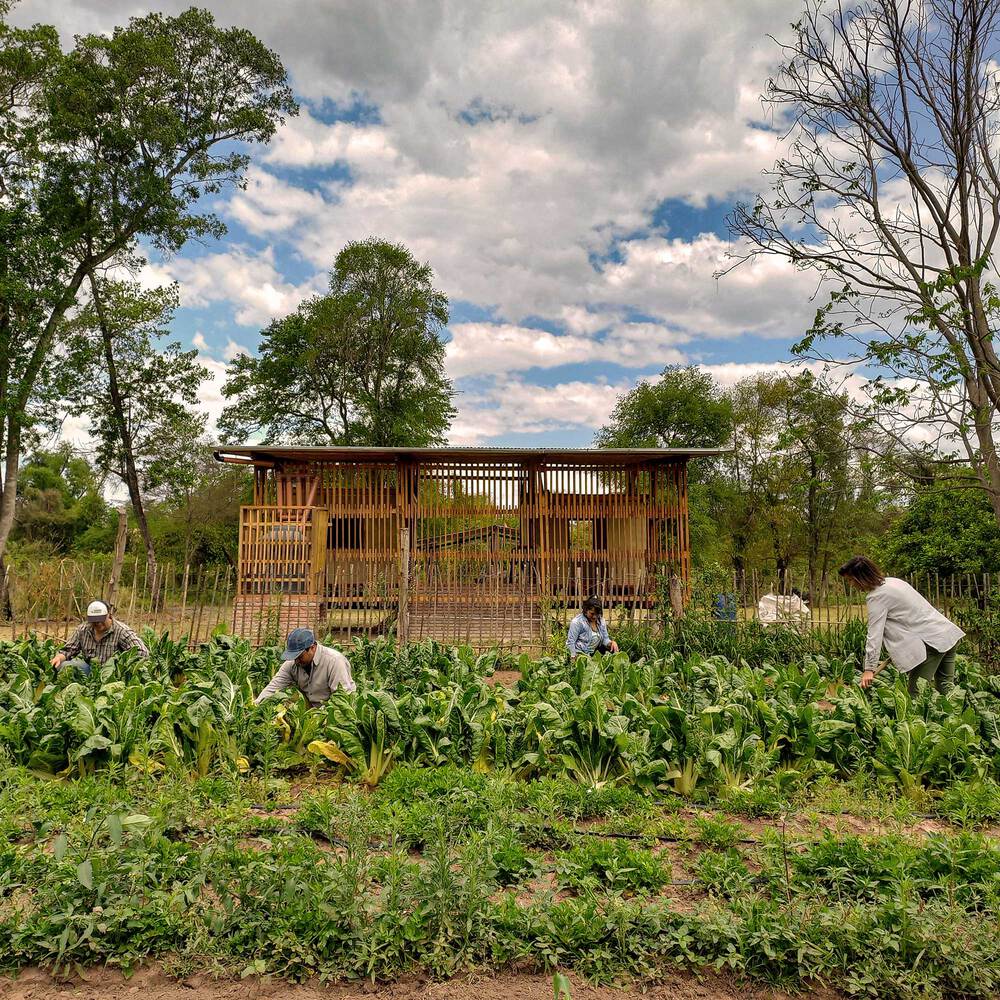Architects: CIMBRA
Area: 45 m²
Year: 2022
Photographs: XhARA
Architects In Charge: Joaquín Trillo (XhARA), Eduardo Tapia
Construction: Mansilla, Puqui, Osvaldo, Agüero, Sergio, Luis y la comunidad guaraní de Arete Guazú
Agroecological Gardens: Franco Herrera, Fernando Anse, Mario Sosa, Juan, Osvaldo, Sergio, Claudia, Beatriz y la comunidad guaraní Arete Guazú
Water Access Facilities: Juan, Puqui, Mansilla y Agüero
Joinery: Toni
General Coordination: Martina Vismara, Claudia Savilla y Luciana Palacio
Execution: CIMBRA, ACDI
Financial Partner: Fortabat
Beneficiary Entity: Comunidad guaraní Areté Guazú
Natural Construction Advisor: XhARA
City: Caimancito
Country: Argentina
The Center for Added Value, a community center designed by XhARA in Caimancito, Jujuy, Argentina, draws inspiration from traditional Chaco ranch structures, integrating bioclimatic solutions rooted in indigenous peasant knowledge. This project employs cross-ventilation, a vertical shade facade, and a unified thermal comfort roof, enhancing the site’s connection with its natural surroundings through innovative reinterpretations of local construction techniques. Integrating social technologies, such as water harvesting and ecological wastewater treatment, emphasizes sustainable practices. Participation from the local Guarani community in the design and construction process ensures that the architecture reflects and serves their cultural and environmental needs.


The Center for Added Value draws inspiration from the shade roof and column-horcón characteristic of the ranches in the Chaco countryside. The Culata Jovai typology consists of facing rooms and is integrated within a continuous space under a roof that provides thermal comfort and unifies the structure. The wattle and daub walls are reinterpreted using a system of sunshades and galleries that enhance the building’s spatial dimensions and foster its integration with the environment.


Referencing regional vernacular architecture and indigenous peasant knowledge, the project activates a series of bioclimatic solutions that form the core proposal. These include cross-ventilation, vertical shade facades, and galleries, among others. Social technologies are also incorporated, featuring a shade roof for thermal comfort and effective water management systems, including harvesting, storage, and ecological wastewater treatment. Inspired by Guarani fences and traditional earth construction techniques, the vertical sunshades filter solar radiation while expanding the building’s spatiality by incorporating galleries and transitional spaces.


The project was developed in collaboration with the Guarani community of Arete Guazú in a participatory construction and design workshop. This collaboration involved sharing knowledge in construction and agriculture to create a dialogue toward culturally resonant solutions. The outcome includes a space dedicated to agroforestry and a center for added value, part of a comprehensive proposal focusing on habitat solutions conducive to food generation.


The use of earth as a construction material is highlighted through the quincha technique, which capitalizes on its hygroscopic properties. This allows the material to absorb and release moisture, providing significant thermal comfort. The structure consists of wooden frames with a cane framework, onto which earth mortar is applied, resulting in lightweight walls with effective thermal insulation. The durability of mortars, plasters, and paints is enhanced by natural additives that increase their resistance to abrasion and erosion.



The methodology avoids imposing solutions that do not align with local realities thus elevating local actors as key designers and decision-makers in the interventions. This approach ensures that the architecture is appropriate for the local climate and cultural practices and responsive to the community’s needs for water and environmental challenges.

Project Gallery















Project Location
Address: Caimancito, Jujuy, Argentina
Location is for general reference and may represent a city or country, not necessarily a precise address.


